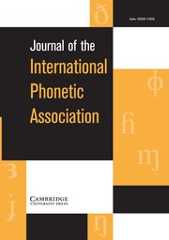- English
- Français
Differences in airstream and posterior place of articulation among Nǀuu clicks
Published online by Cambridge University Press: 10 July 2009
- Amanda L. Miller
- Affiliation:Department of Linguistics, Cornell Universityam332@cornell.edu
- Johanna Brugman
- Affiliation:Department of Linguistics, Cornell Universityjcb52@cornell.edu
- Bonny Sands
- Affiliation:Department of English, Northern Arizona Universitysands@lowell.edu
- Levi Namaseb
- Affiliation:Department of Language and Literature Studies, The University of Namibialnamaseb@unam.na
- Mats Exter
- Affiliation:Institut für Linguistik, Allgemeine Sprachwissenschaft, Universität zu Kölnmats.exter@uni-koeln.de
- Chris Collins
- Affiliation:Department of Linguistics, New York Universitycc116@nyu.edu
Abstract
This paper describes the consonant inventory of the endangered southern African language Nǀuu. Our novel approach to segment classification accounts for all 73 Nǀuu consonants with just four phonetic dimensions (place, manner, phonation, airstream) and does away with the phonetically empty categoryclick accompaniment. We provide ultrasound data showing that the posterior constrictions in clicks are not produced at the ‘velar’ place of articulation, and that posterior place differs with anterior place. We therefore argue for a terminological shift fromvelaric tolingual airstream mechanism. Our data also show that the posterior place of articulation is the same in Nǀuu's five lingual ([⊙ ǀ ǃ ǁ ǂ]) and linguo-pulmonic ([ ]) stops. We argue that the difference between these segment classes is best captured in terms of airstream, not place. Plain clicks use only the lingual airstream, while linguo-pulmonic segments are airstream contours, in which the transition to the pulmonic airstream occurs within the segment rather than at its boundary. Our evidence suggests that the contrast between ‘velar’ and ‘uvular’ clicks proposed for the related language ǃXóõ is likely also one of airstream and that a contrast solely in terms of posterior place would be articulatorily impossible.
]) stops. We argue that the difference between these segment classes is best captured in terms of airstream, not place. Plain clicks use only the lingual airstream, while linguo-pulmonic segments are airstream contours, in which the transition to the pulmonic airstream occurs within the segment rather than at its boundary. Our evidence suggests that the contrast between ‘velar’ and ‘uvular’ clicks proposed for the related language ǃXóõ is likely also one of airstream and that a contrast solely in terms of posterior place would be articulatorily impossible.
- Type
- Research Article
- Information
- Copyright
- Copyright © International Phonetic Association 2009
Access options
Get access to the full version of this content by using one of the access options below. (Log in options will check for institutional or personal access. Content may require purchase if you do not have access.)Article purchase
Temporarily unavailable
References
Miller et al. sound files
Sound files zip. These audio files are licensed to the IPA by their authors and accompany the phonetic descriptions published in the Journal of the International Phonetic Association. The audio files may be downloaded for personal use but may not be incorporated in another product without the permission of Cambridge University Press
- 21
- Cited by


